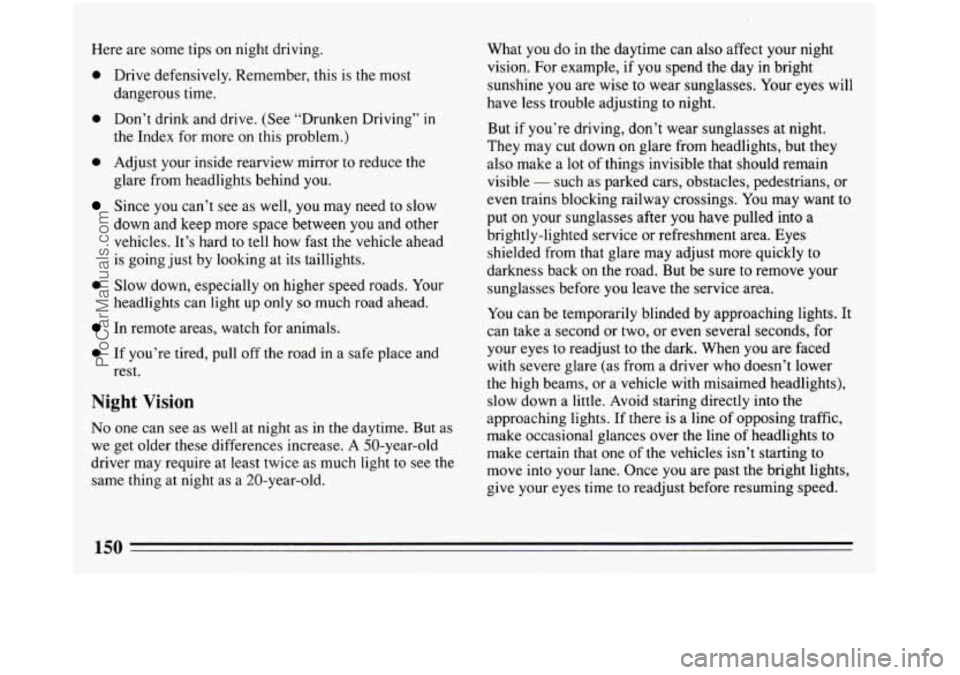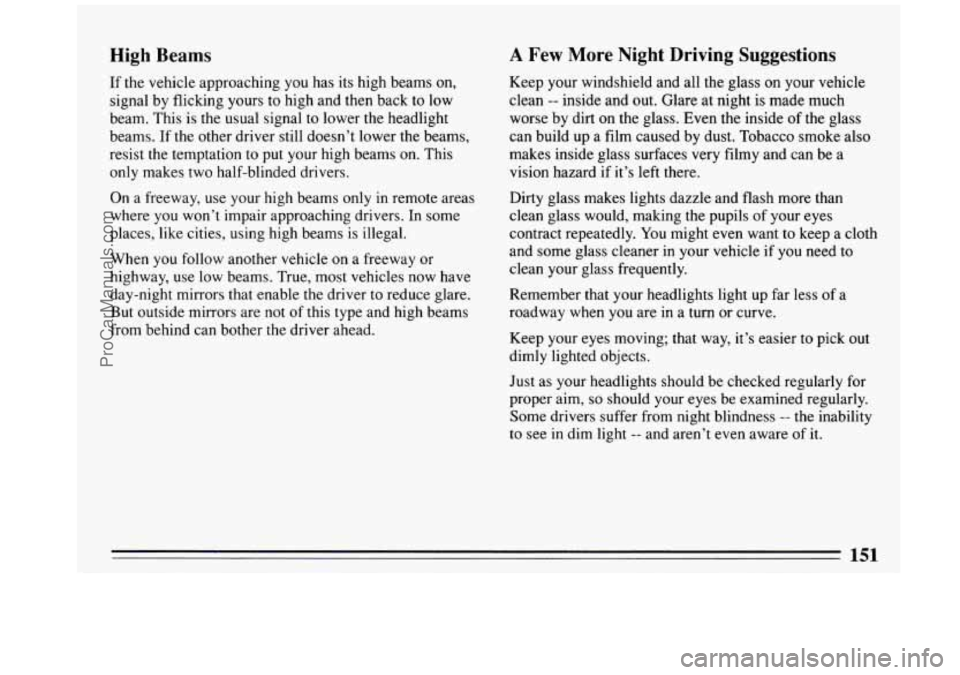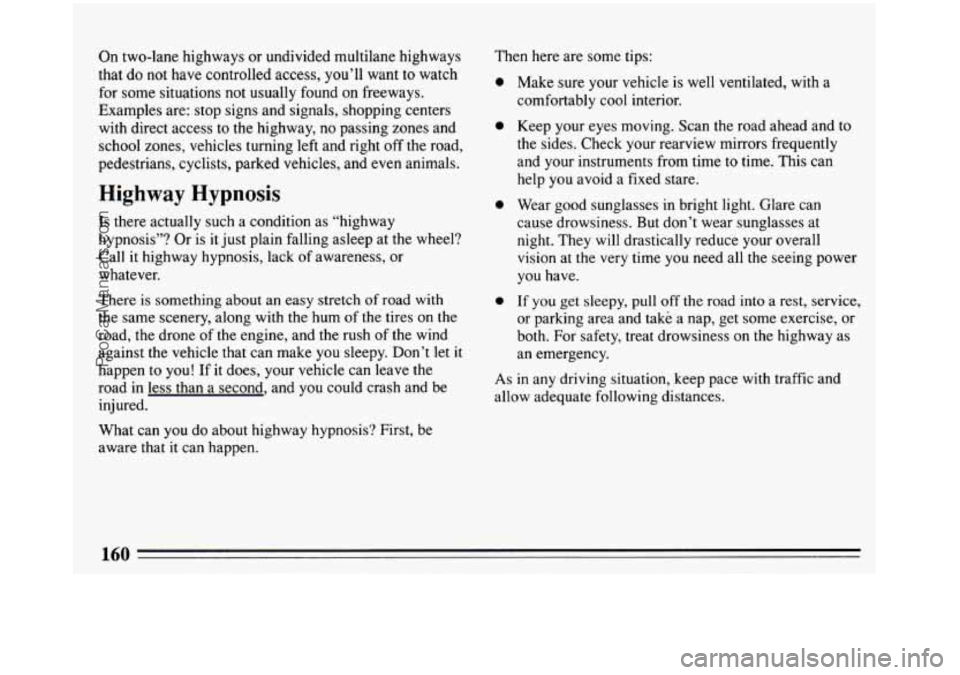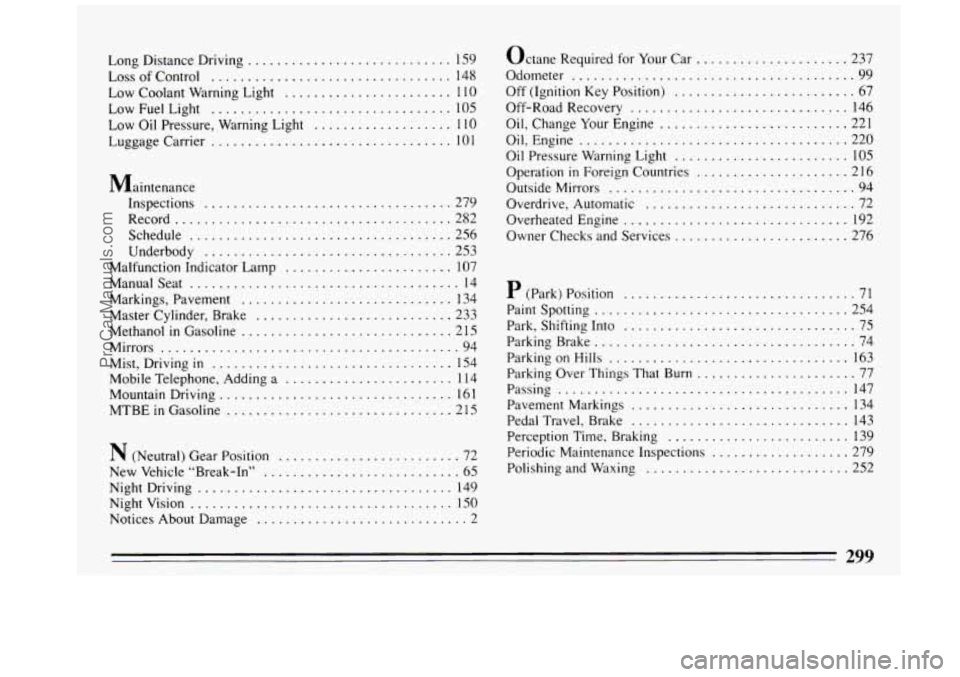night vision BUICK REGAL 1993 Owners Manual
[x] Cancel search | Manufacturer: BUICK, Model Year: 1993, Model line: REGAL, Model: BUICK REGAL 1993Pages: 308, PDF Size: 16.35 MB
Page 151 of 308

the accelerator pedal as soon as you feel the vehicle start
to slide. Quickly steer the way you want the vehicle to
go. If you start steering quickly enough, your vehicle
will straighten
out. As it does, straighten the front
wheels.
Of course, traction is reduced when water, snow, ice,
gravel, or other material is on the road. For safety, you’ll
want to slow down and adjust your driving to these
conditions.
It is important to slow down on slippery
surfaces because stopping distance will be longer and
vehicle control more limited.
While driving on a surface with reduced traction, try
your best to avoid sudden steering, acceleration, or
braking (including engine braking
by shifting to a lower
gear). Any sudden changes could cause the tires to slide.
You may not realize the surface is slippery until your
vehicle is skidding. Learn to recognize warning clues
--
such as enough water, ice or packed snow on the road to
make a “mirrored surface” -- and slow down when you
have any doubt.
If you have the anti-lock braking system, remember: It
helps avoid only the braking skid. If you do not have
anti-lock, then in a braking skid (where the wheels are
no longer rolling), release enough pressure on the brakes
to get the wheels rolling again. This restores steering
control. Push the brake pedal down steadily when you have
to stop suddenly.
As long as the wheels are rolling,
you will have steering control. Steer the way you want
to go.
Driving at Night
Night driving is more dangerous than day driving. One
reason is that some drivers are likely
to be impaired --
by alcohol or drugs, with night vision problems, or by
fatigue.
149
ProCarManuals.com
Page 152 of 308

Here are some tips on night driving.
0 Drive defensively. Remember, this is the most
dangerous time.
0 Don’t drink and drive. (See “Drunken Driving” in
the Index for more on this problem.)
0 Adjust your inside rearview mirror to reduce the
glare from headlights behind
you.
Since you can’t see as well, you may need to slow
down and keep more space between
you and other
vehicles. It’s hard
to tell how fast the vehicle ahead
is going just by looking at its taillights.
0 Slow down, especially on higher speed roads. Your
headlights can light up
only so much road ahead.
In remote areas, watch for animals.
0 If you’re tired, pull off the road in a safe place and
rest.
Night Vision
No one can see as well at night as in the daytime. But as
we get older these differences increase.
A 50-year-old
driver may require at least twice as much light
to see the
same thing at night as a 20-year-old. What
you do in the daytime can also affect your night
vision. For example, if you spend the day
in bright
sunshine
you are wise to wear sunglasses. Your eyes will
have less trouble adjusting to night.
But
if you’re driving, don’t wear sunglasses at night.
They may cut down on glare from headlights, but they
also make a lot of things invisible that should remain
visible
- such as parked cars, obstacles, pedestrians, or
even trains blocking railway crossings.
You may want to
put
on your sunglasses after you have pulled into a
brightly-lighted service or refreshment area. Eyes
shielded from that glare may adjust more quickly to
darkness back on the road. But be sure
to remove your
sunglasses before you leave the service area.
You can be temporarily blinded by approaching lights. It
can take a second or two, or even several seconds, for
your
eyes to readjust to the dark. When you are faced
with severe glare (as from a driver who doesn’t lower
the high beams, or a vehicle with misaimed headlights),
slow down a little. Avoid staring directly into
the
approaching lights. If there is a line of opposing traffic,
make occasional glances over the line of headlights
to
make certain that one of the vehicles isn’t starting to
move into your lane. Once you are past the bright lights,
give your eyes time to readjust before resuming speed.
150
ProCarManuals.com
Page 153 of 308

High Beams
If the vehicle approaching you has its high beams on,
signal by flicking yours
to high and then back to low
beam. This is the usual signal to lower the headlight
beams. If the other driver still doesn’t lower the beams,
resist the temptation to put your high beams on. This
only makes two half-blinded drivers.
On a freeway, use your high beams only in remote areas
where you won’t impair approaching drivers. In some
places, like cities, using high beams is illegal.
When
you follow another vehicle on a freeway or
highway, use low beams. True, most vehicles now have
day-night mirrors that enable the driver
to reduce glare.
But outside mirrors are not
of this type and high beams
from behind can bother the driver ahead.
A Few More Night Driving Suggestions
Keep your windshield and all the glass on your vehicle
clean
-- inside and out. Glare at night is made much
worse by dirt on the glass. Even the inside of the glass
can build up a film caused by dust. Tobacco smoke also
makes inside glass surfaces very filmy and can be
a
vision hazard if it’s left there.
Dirty glass makes lights dazzle and flash more than
clean glass would, making the pupils of your eyes
contract repeatedly.
You might even want to keep a cloth
and some glass cleaner in your vehicle if you need
to
clean your glass frequently.
Remember that your headlights light up far less of a
roadway when you are in a turn or curve.
Keep your eyes moving; that way, it’s easier to pick out
dimly lighted objects.
Just as your headlights should be checked regularly for
proper aim,
so should your eyes be examined regularly.
Some drivers suffer from night blindness
-- the inability
to see in dim light
-- and aren’t even aware of it.
151
ProCarManuals.com
Page 162 of 308

On two-lane highways or undivided multilane highways
that do not have controlled access, you’ll want to watch
for some situations not usually found on freeways.
Examples are: stop signs and signals, shopping centers
with direct access to the highway, no passing zones and
school zones, vehicles turning left and right
off the road,
pedestrians, cyclists, parked vehicles, and even animals.
Highway Hypnosis
Is there actually such a condition as “highway
hypnosis”? Or is it just plain falling asleep at the wheel?
Call it highway hypnosis, lack
of awareness, or
whatever.
There is something about an easy stretch
of road with
the same scenery, along with the hum of
the tires on the
road, the drone of the engine, and the rush
of the wind
against the vehicle that can make
you sleepy. Don’t let it
happen to
you! If it does, your vehicle can leave the
road in less than a second, and you could crash and be
inj ured.
What can you
do about highway hypnosis? First, be
aware that it can happen. Then
here are some tips:
0
0
0
0
Make sure your vehicle is well ventilated, with a
comfortably cool interior.
Keep your eyes moving. Scan the road ahead and to
the sides. Check your rearview mirrors frequently
and your instruments from time
to time. This can
help you avoid a fixed stare.
Wear good sunglasses in bright light. Glare can
cause drowsiness. But don’t wear sunglasses at
night. They will drastically reduce your overall
vision at
the very time you need all the seeing power
you have.
If you get sleepy, pull off the road into a rest, service,
or parking area and take a nap, get some exercise, or
both. For safety, treat drowsiness on
the highway as
an emergency.
As in any driving situation, keep pace with traffic and
allow adequate following distances.
ProCarManuals.com
Page 301 of 308

Long Distance Driving ............................ 159
LossofControl
................................. 148
Low Coolant Warning Light
....................... 110
Low Fuel Light ................................. 105
Low Oil Pressure. Warning Light ................... 110
Luggage Carrier ..............................
Maintenance
Inspections
.............
Record .................
..................
..................
. . 101
... 279
... 282
Schedule
.................................... 256
Underbody
.................................. 253
Malfunction Indicator Lamp
....................... 107
Manualseat
..................................... 14
Markings. Pavement
............................. 134
Master Cylinder. Brake
........................... 233
Methanol
in Gasoline ............................. 215
Mirrors
......................................... 94
Mist, Driving
in ................................. 154
Mobile Telephone, Adding a
....................... I14
Mountain Driving
................................ 16 1
MTBE in Gasoline ............................... 215
N (Neutral) Gear Position ......................... 72
New Vehicle “Break-In”
........................... 65
NightDriving ................................... 149
Nightvision
.................................... 150
Notices About Damage
............................. 2 Octane
Required for Your Car
..................... 237
Odometer
....................................... 99
Off (Ignition Key Position) ......................... 67
Off-Road Recovery
.............................. 146
Oil. Change Your Engine .......................... 221
Oil. Engine
..................................... 220
Oil Pressure Warning Light
........................ 105
Operation in Foreign Countries ..................... 216
Outside Mirrors
.................................. 94
Overdrive, Automatic
............................. 72
Overheated Engine
............................... 192
Owner Checks and Services
........................ 276
P (Park) Position ................................ 71
Paint Spotting
................................... 254
Park. Shifting Into
................................ 75
Parking Brake
.................................... 74
Parking on Hills
................................. 163
Parking Over Things That Burn
...................... 77
Pavement Markings
.............................. 134
PedalTravel, Brake
.............................. 143
Perception Time, Braking
......................... 139
Periodic Maintenance Inspections
................... 279
Polishing and Waxing
............................ 252
Passing
........................................ 147
299
ProCarManuals.com